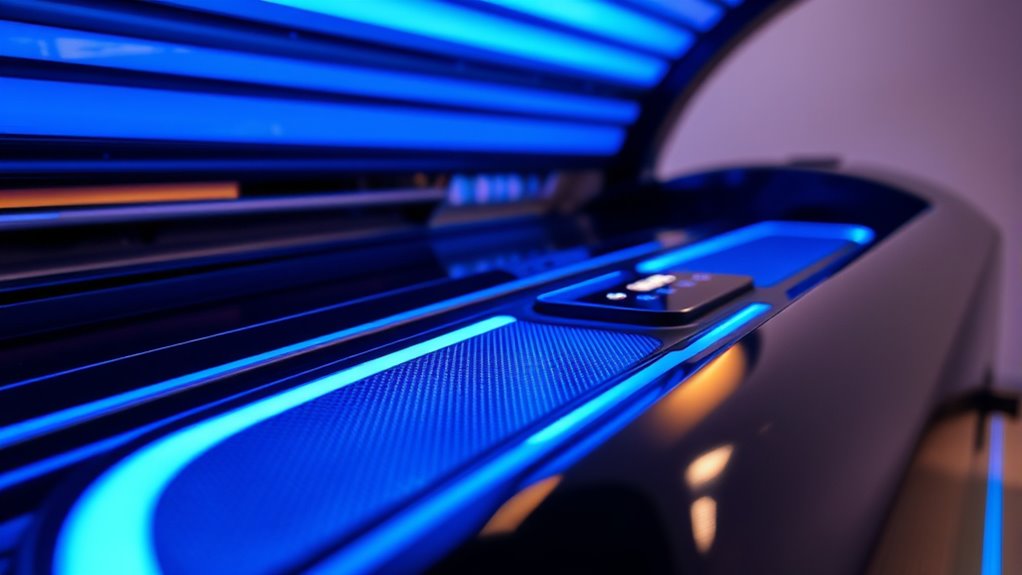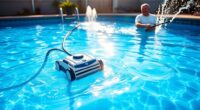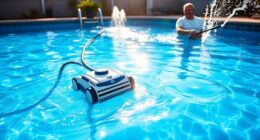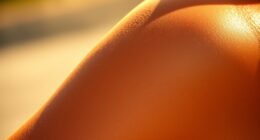Using a tanning bed is unsafe because it exposes you to high levels of UVA radiation that considerably increase your risk of skin cancer, skin aging, and eye damage. Despite myths, tanning beds do not provide safe or effective vitamin D, and frequent use, especially before age 20, worsens health risks. Safer alternatives like self-tanners and vitamin D supplements exist. If you want to understand how to protect your skin, there’s more you should know.
Key Takeaways
- Tanning beds emit mostly UVA rays, which can cause DNA damage, skin aging, and significantly increase skin cancer risk, including melanoma.
- Starting indoor tanning before age 20 or 35 raises melanoma and other skin cancer risks substantially.
- No tanning bed is completely safe; all expose users to harmful UV radiation, which damages skin regardless of perceived safety.
- Safer alternatives like self-tanning products and vitamin D-rich diets can provide skin color and health benefits without UV exposure.
- Regulatory measures worldwide aim to restrict youth access and promote awareness of the health risks associated with tanning bed use.
The Risks of Skin Cancer From Indoor Tanning

Have you ever wondered how safe indoor tanning really is? The truth is, it *considerably* increases your risk of skin cancer. Indoor tanning raises the chances of basal cell carcinoma (BCC) by about 24% to 29% and squamous cell carcinoma (SCC) by 58% to 83%. If you start tanning before age 20, your risk of melanoma jumps by 47% to 75%. Using tanning beds early in life doubles the chance of developing skin cancer before age 40. Each year, over 419,000 cases of skin cancer in the U.S. are linked to indoor tanning. Women and young people are especially vulnerable, with frequent tanners at even higher risk. Overall, indoor tanning is a major contributor to skin cancer, making it far from a safe activity. Proper installation and maintenance of protective measures can reduce some risks, but they do not eliminate the danger posed by UV exposure from tanning beds. Additionally, many users underestimate the long-term health effects associated with UV exposure, which can be severe and persistent. Awareness of UV radiation risks can empower you to make safer choices regarding skin health.
How Tanning Beds Emit Intense UVA Radiation

Tanning beds primarily emit UVA rays, with up to 98% of their radiation falling into this category, which differs especially from natural sunlight’s balanced spectrum. The UVA levels in tanning beds can be 10 to 15 times higher than what you’d experience outdoors. While they do emit some UVB, it’s a minor fraction. The fluorescent bulbs in these devices are engineered to maximize UVA output, focusing on wavelengths between 320 and 400 nm that penetrate deeper into your skin. High-pressure lamps tend to produce more UVA relative to UVB, and a 20-minute session can deliver UVA doses equivalent to hours of midday sun. Because of these intense emissions, tanning beds expose your skin to far more UVA radiation than natural sunlight, increasing the risk of long-term skin damage. Understanding the risks of UVA radiation is essential for making informed decisions about tanning. Additionally, the spiritual energy involved in such activities can influence one’s overall well-being and perception of health, emphasizing the importance of choosing safe practices. Recognizing the intensity of UV radiation emitted by tanning beds underscores the importance of protective measures and informed choices.
Myths and Misconceptions About Tanning Bed Safety
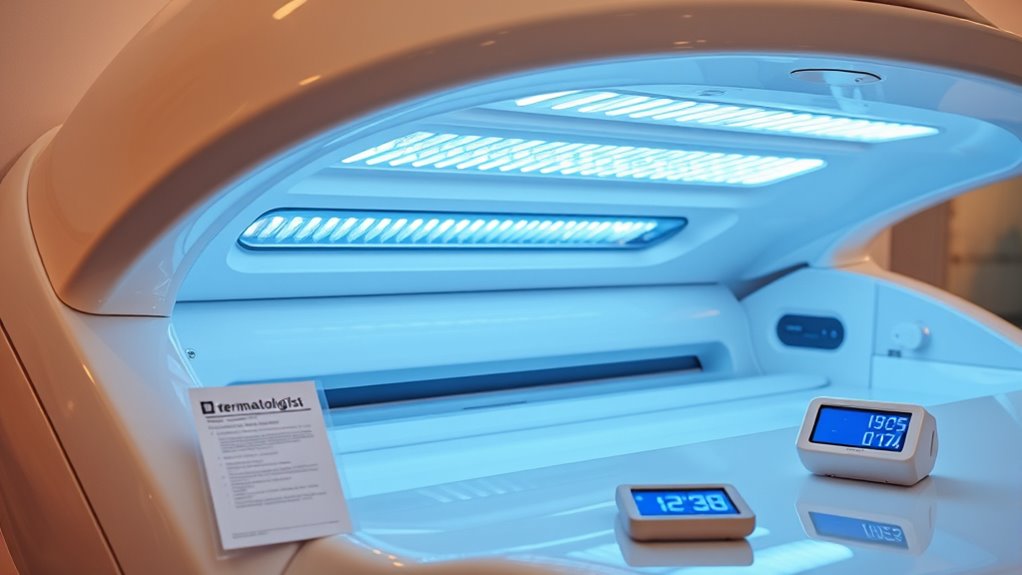
Many people believe that tanning beds are a safer alternative to sun exposure, but this is a misconception. Tanning beds emit UV radiation more intensely than midday sun, increasing your risk of skin damage and cancer. Controlled exposure doesn’t eliminate harm; even short sessions cause skin cell damage, and overuse raises your risk further. Many think using tanning beds before age 20 won’t impact their health, but it actually increases melanoma risk by nearly 50%. It’s also false that tanning beds are safer because they use UVA light; both UVA and UVB damage your skin. A false sense of security leads to risky behavior, like seeking a tan without considering the long-term dangers. Remember, no tanning bed is safe—every session exposes you to harmful UV radiation. Incorporating protective styling benefits like those found in crochet styles can serve as a safer alternative to tanning. Additionally, understanding the cybersecurity vulnerabilities associated with tanning salon systems can help consumers make more informed choices about where they seek tanning services. Furthermore, many users underestimate the long-term health effects of repeated UV exposure from tanning beds. Research also indicates that tanning beds can disrupt your body’s natural sleep cycles and circadian rhythms, which are crucial for overall health.
Why Tanning Does Not Provide Adequate Vitamin D

While UVB radiation is essential for your skin to produce vitamin D, most tanning beds primarily emit UVA light, which doesn’t contribute much to vitamin D synthesis. Only specialized lamps with a significant UVB component can stimulate vitamin D production, and many modern tanning beds are designed for cosmetic tanning with minimal UVB output. As a result, typical tanning sessions often fail to produce enough vitamin D, especially since UVB doses vary based on lamp type and exposure time. Additionally, UVB exposure can cause skin damage and increase the risk of skin cancer, making reliance on tanning beds for vitamin D production particularly risky. Instead, health experts recommend obtaining vitamin D through diet, supplements, or safe sun exposure rather than tanning beds.
The Impact of Age and Frequency on Tanning Risks
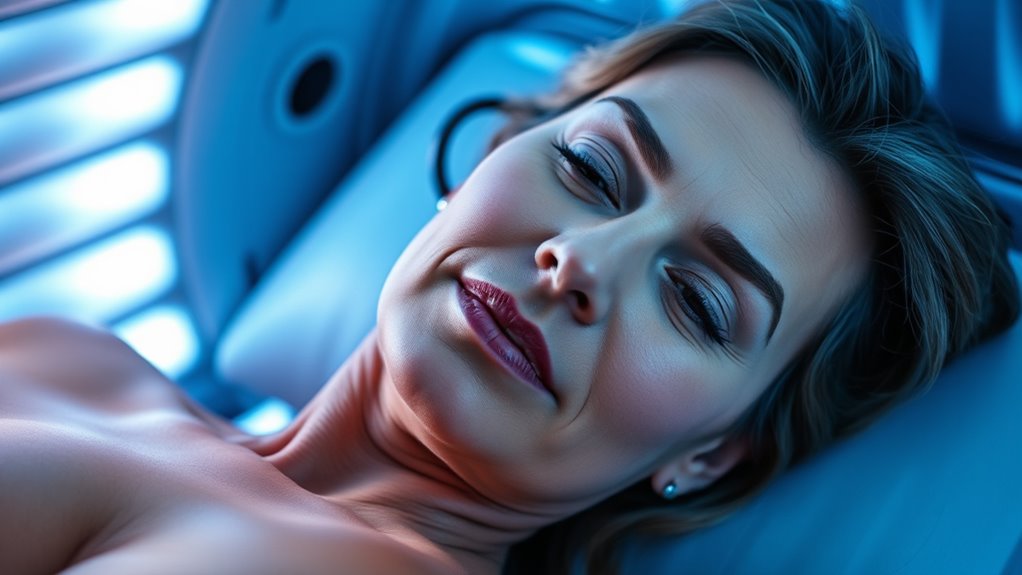
Starting tanning bed use at a young age considerably increases your risk of developing skin cancer later in life. If you begin before age 35, your melanoma risk jumps by about 59%, and your chances of melanoma become 1.75 times higher than if you start later. Early use also raises the risk of squamous cell carcinoma by 67% and basal cell carcinoma by 29%. The more frequently you tan, especially 10 or more times per year, the greater your cumulative UV exposure, which amplifies your risk of skin damage and cancer. Kids and teens are especially vulnerable because their skin is still developing and more sensitive to UV damage. Starting young and tanning often lead to risky behaviors like tanning without protection or falling asleep in beds, further increasing danger. Awareness of Modern Toilet features such as water-saving dual-flush systems can help promote healthier bathroom habits, reducing overall water waste. Additionally, understanding the risks of UV exposure can motivate safer choices and decrease the likelihood of long-term health consequences. Recognizing the importance of proper skin protection during all sun-related activities is crucial in minimizing these risks.
Regulatory Efforts and Legislation Against Indoor Tanning
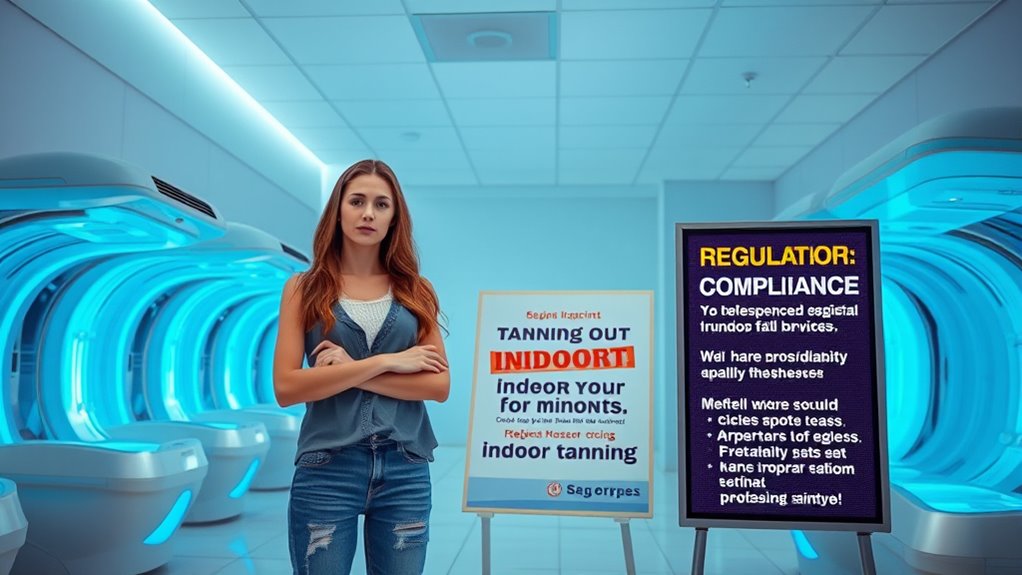
Regulatory efforts and legislation targeting indoor tanning have rapidly expanded worldwide in response to growing concerns about skin cancer risks. About half of European countries have implemented strict bans on tanning beds for minors, while Australia enforces a nationwide ban on commercial tanning beds. In North America, regulations vary across states, provinces, and territories, with 44 U.S. states plus D.C. restricting or banning minors’ access. Since 2003, more countries have adopted youth tanning restrictions, rising from 2 to 11 by 2011. Many local U.S. jurisdictions have also enacted their own laws. Additionally, nearly half of legislative units globally ban or regulate advertising, and about 64 require health risk disclosures. These efforts aim to reduce early UV exposure and improve public awareness of tanning dangers. Encouraging safer alternatives, such as self-tanning products, can help individuals avoid harmful UV exposure while still achieving a desired appearance. Promoting public health awareness is essential for reducing long-term skin damage and associated risks.
Additional Health Concerns Beyond Skin Cancer

In addition to increasing the risk of skin cancer, indoor tanning poses several other serious health concerns. UV radiation from tanning beds accelerates premature skin aging, leading to wrinkles, leathery texture, and sagging skin. It can cause redness, blotches, yellowing, and increase freckles and age spots. DNA damage from UV exposure impairs skin cell function beyond cancer risk. Tanning beds also weaken your immune system, reducing your skin’s defenses and increasing susceptibility to infections. Without proper eye protection, UV rays can cause photokeratitis, cataracts, and even eye cancer over time. Additionally, UV exposure may trigger photosensitivity reactions, worsen skin conditions, and cause allergic responses. While some believe tanning boosts vitamin D, the risks far outweigh any potential benefits, making indoor tanning a significant health hazard.
The Psychological and Social Aspects of Tanning Addiction
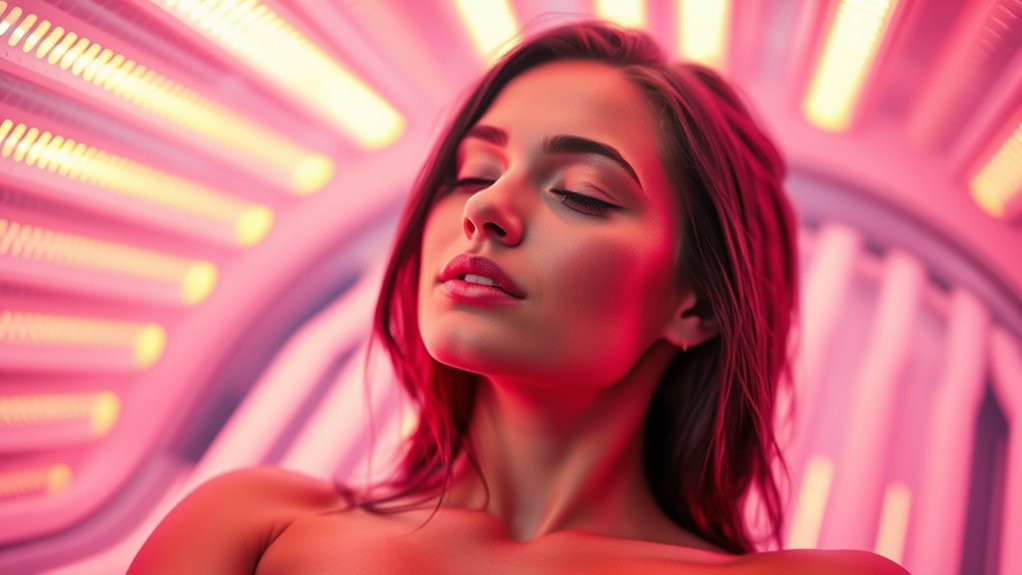
Many people develop a psychological and social attachment to tanning that can lead to addiction, driven by beliefs about beauty and social acceptance. You might feel pressured to maintain a tan because of societal standards or media influence, where a tanned appearance is seen as attractive or healthier. This desire often stems from social circles or peer influence, reinforcing tanning habits. Psychological factors like body dysmorphic disorder or OCD can make tanning feel essential to self-image, while feelings of anxiety or depression may lead you to seek mood boosts from UV exposure. The biological effects, such as mood elevation from endorphin release, can create a dependency. As a result, tanning becomes more than just a beauty routine—it becomes intertwined with your mental health and social identity. Additionally, some individuals may turn to tanning as a form of skincare innovation to manage skin concerns or enhance their appearance, further reinforcing their tanning habits. Moreover, skin health considerations can be overlooked in the pursuit of a certain aesthetic. Furthermore, research indicates that the home tanning industry actively promotes tanning as a safe and glamorous activity, influencing perceptions and behaviors. Understanding the psychological triggers behind tanning addiction can help in developing healthier attitudes towards skin care and appearance.
Alternatives to Tanning for a Healthy Glow

If you’re looking for a healthy way to achieve a sun-kissed glow, there are plenty of safe alternatives to tanning beds that can give you beautiful results without risking your skin. Self-tanning lotions and mousses contain DHA, which reacts with your skin’s surface to create a temporary tan without UV exposure. Spray tans offer an even, professional application, delivering long-lasting results. Bronzing drops and tinted moisturizers provide quick, subtle color boosts, often with added skincare benefits like hydration. Gradual tanning lotions build color gradually, keeping your skin nourished. You can also use makeup, body bronzers, or shimmer creams for instant, wash-off glow. These options are risk-free, easy to use, and help you achieve a natural-looking tan without damaging your skin. Exploring best beaches can also inspire your choice of outdoor activities and natural sun exposure for a healthier glow.
What You Should Know Before Using a Tanning Bed
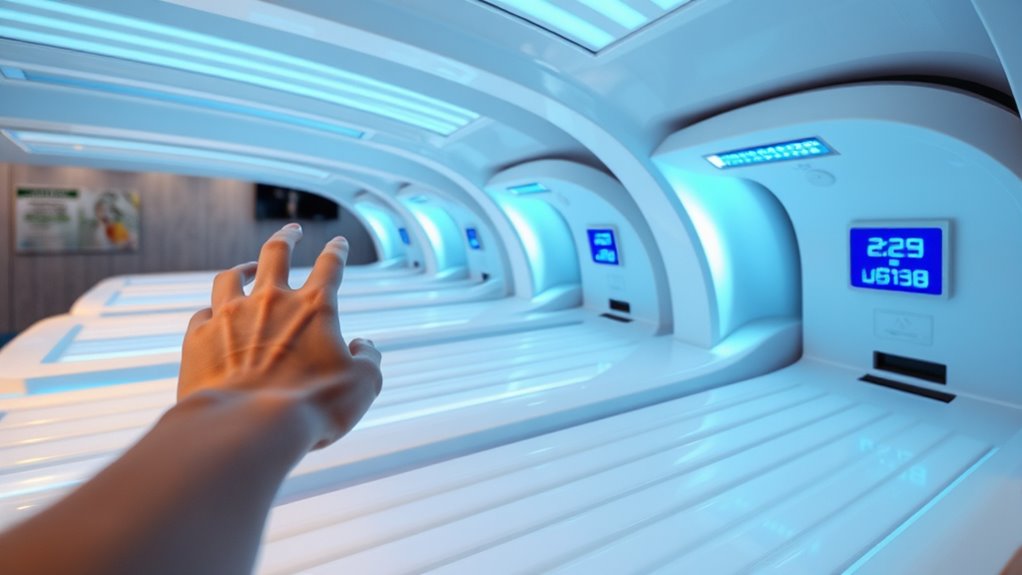
Before stepping into a tanning bed, it’s crucial to understand the significant health risks involved. Tanning beds mainly emit UVA rays, which penetrate deeply, damaging DNA and increasing your risk of skin cancers like melanoma, basal cell, and squamous cell carcinoma. Even using a tanning bed once before age 35 raises melanoma risk by 75%, and repeated use makes it worse. No UV tan from tanning beds or natural sun exposure is safe; all UV exposure damages skin cells, causing premature aging and irreversible photo damage. Tanning beds also pose eye risks, including cataracts and rare eye cancers, especially without proper eye protection. Regulations vary, but many health experts advocate banning minors from using tanning beds due to these dangers. Always weigh these risks carefully before considering indoor tanning.
Frequently Asked Questions
Can Tanning Beds Be Completely Safe With Proper Use?
You wonder if tanning beds can be completely safe with proper use. The truth is, no level of tanning bed use is risk-free. Even minimal or occasional sessions expose you to harmful UVA and UVB rays that can increase your chances of skin cancer, including melanoma. Reputable health organizations agree there’s no safe way to use tanning beds, so avoiding them altogether is your best choice for skin health.
Are There Any Legitimate Health Benefits to Indoor Tanning?
Imagine a sunlit morning promising warmth and importance—that’s what some believe indoor tanning offers. You might think it boosts your mood, enhances confidence, or helps with vitamin D. While these perceived benefits seem appealing, they’re often overshadowed by serious health risks like skin cancer, premature aging, and eye damage. Despite some claims, the real health benefits are limited, and the dangers far outweigh any superficial gains.
How Does Tanning Bed Exposure Compare to Natural Sunlight in Risks?
You’re asking how tanning bed exposure compares to natural sunlight risks. Tanning beds emit much higher UVA rays—up to 12 times more—penetrating deeper and causing more DNA damage. Unlike sunlight, they lack UVB rays, which help produce vitamin D but also cause sunburn. Overall, tanning beds pose greater skin cancer risks and accelerate aging more than natural sunlight, making them a dangerous choice for tanning.
Is There a Safe Way to Get Vitamin D Without Tanning Beds?
Imagine shining light on your health without risking the dark shadows of skin damage. You can safely get vitamin D through diet—fatty fish, fortified foods, mushrooms exposed to UV light—and supplements, which act as a guiding torch in winter months or low sunlight. These methods let you bask in wellness without the harmful rays of tanning beds, keeping your skin safe while nourishing your body’s essential vitamin D needs.
What Are the Long-Term Skin Aging Effects of Tanning Bed Use?
Long-term tanning bed use accelerates skin aging markedly. You’ll notice wrinkles, age spots, and sagging skin appearing earlier than normal. UV rays damage elastin and collagen, leading to loss of elasticity and firmness. You might also develop persistent dark spots and uneven pigmentation. Over time, this damage increases your risk of skin cancer and other skin issues, making premature aging a serious consequence of regular tanning bed use.
Conclusion
While it might seem tempting to chase that perfect tan, remember that indoor tanning poses serious health risks, including skin cancer. Don’t buy into the myth that it’s safe or a good way to get vitamin D—there are healthier options. Protect your skin and well-being by choosing safer alternatives for a glow. Your future self will thank you for making smarter choices today, even if it means skipping the tanning bed.
